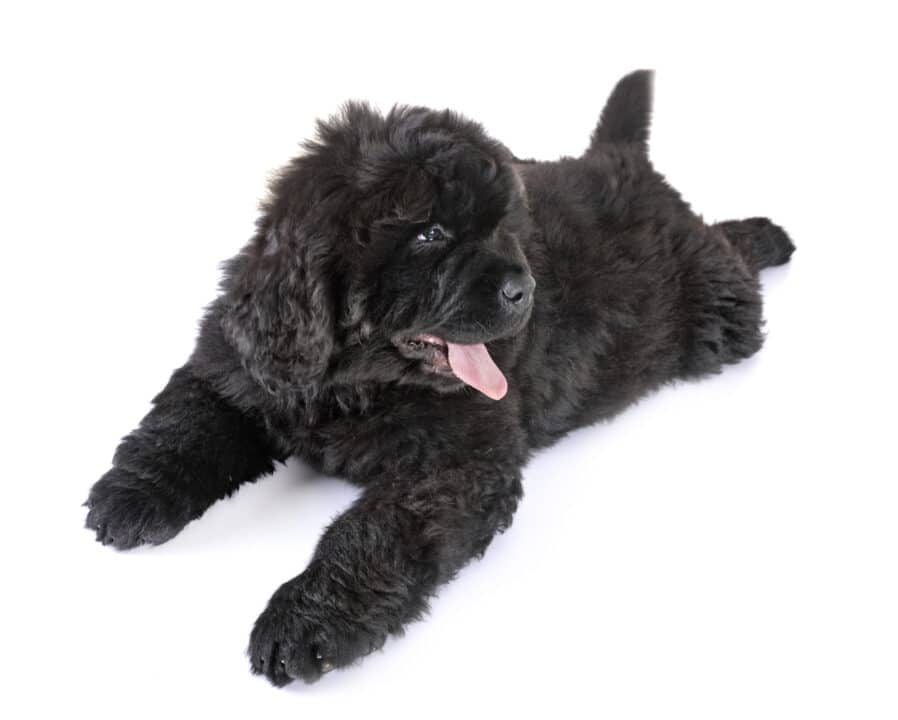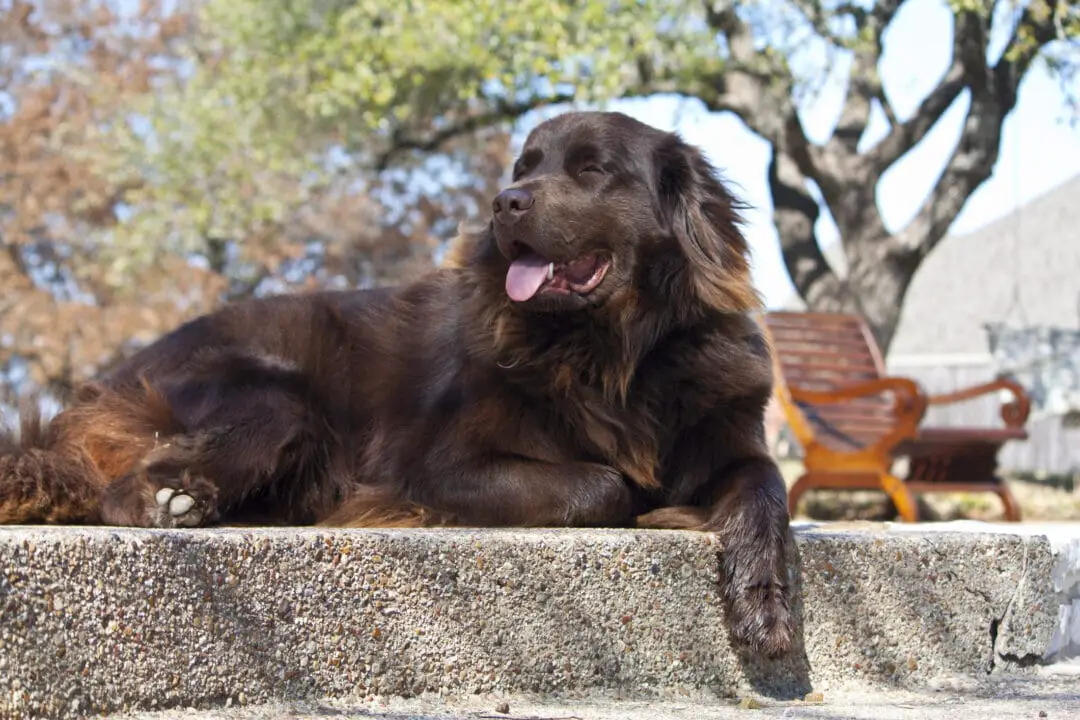Newfoundlands are gorgeous dogs with so much to offer! That being said, they need consistent grooming to stay healthy, happy, and clean. Many owners struggle with figuring out how often their Newfoundland should be bathed.
How often your Newfoundland should be bathed will come down to many different factors. Generally, you should be bathing your Newfoundland once every one to two months. This dog breed can go longer between bathing as long as they do not make a mess. This is due to their water-resistant coat.
Newfoundlands love water, but bathing them can be quite a challenge! It is common for owners to have difficulty figuring out a bathing schedule that works for everyone. If this sounds familiar, keep reading to find out everything you should know about bathing your Newfoundland!
Why Is It Important to Bathe Your Newfoundland Regularly?
Newfoundlands have beautiful double coats that are actually water-resistant! As a result, they need regular grooming to stay healthy; this includes bathing. Their water-resistant coat can become oily, but getting rid of this oil can actually dry out their skin and potentially cause skin problems. This is why it is important to find a regular bathing schedule that works for both of you!
In addition, their thick coat can lead to some messes or matted fur that need a good washing to come free. Luckily, Newfoundlands absolutely love water! Regular bathing will keep your Newfie clean, healthy, and smelling good.
Newfoundlands Can Appear Dirty Due to Their Thick Coats
Newfoundlands are named so because they are believed to have originated from the island of Newfoundland in Canada! They were originally ship dogs, helping fishermen and navigating the cold waters in harsh winter. As a result, they have thick double-sided coats to protect them from the cold water and weather.
The outer coat of a Newfoundland is more coarse and lies flat. It has the oily, water-resistant quality that makes Newfies such fantastic water dogs! The undercoat is softer and thicker and helps keep them warm. This thick coat means that Newfoundlands can often appear dirty.
Their long fur can become matted or tangled easily, and oil build-up can make their coat look dull. Newfoundlands can also get into messes or dirt that easily gets caught in their thick coat. These are all a few reasons why these lovely coats should be washed regularly.
Factors That Affect a Newfie’s Bathing Requirements

As previously mentioned, every Newfoundland is different and various factors can impact how often they should be bathed. Time will also be a good indicator, as you naturally learn more about your dog’s quirks the longer you have them!
That being said, here are some different factors that may impact your Newfie’s bathing requirements:
Length of fur
The length of fur on a Newfoundland has a big impact on how often they need to be bathed. It is common for longer fur to become tangled and matted, and it can be hard to notice these tangles due to length.
Eventually, washing with a quality shampoo becomes the best way to deal with the matted fur. In addition, long fur means your Newfie will be more likely to pick up dirt and other messes as they run around outside.
Your Newfoundland should have their fur trimmed every few months as part of its regular grooming.
Fur that is trimmed close to the body may collect more oil but is less likely to pick up the outdoor mess; on the opposite end, long fur can tangle and bring the outdoors inside! Whatever length of fur works best for your Newfie, make sure to wash them regularly.
2. Amount of shedding
Most Newfoundland dogs will have increased amounts of shedding in the spring and fall seasons. To help you picture the increase in shedding, you’ll go from brushing about once a week to brushing every day until the shedding stops!
This amount of shedding can impact how often you bathe your Newfoundland.
Many owners find that increased bathing during shedding seasons helps get rid of excess hair and keeps the shedding under control.
High-quality dog shampoo can also improve the overall sheen of the coat that is left behind. While shedding season can catch new owners unawares, after a few years you will be adept at recognizing the signs and increasing your bathing schedule as needed.
3. Their activity levels
Most Newfoundlands are relatively low energy compared to other dog breeds. However, every dog is different and their activity levels will definitely play a part in how often they need to be bathed.
While experts recommend Newfoundlands get between 20 and 40 minutes of exercise each day, activities like running or swimming can impact things like smell, fur appearance, and potential damage to the hairs of their coat.
Dirt and debris from high activity taking place outdoors can cling to the skin. This is a reason that Newfies can sometimes develop skin allergies or lesions where the coat and underlying skin have not been properly cleaned.
A low-energy Newfoundland can also need to be bathed depending on where they regularly lay down – if they stay put in a dirty or muddy area, frequent bathing will be needed.
4. Type of food eaten
Many dog owners may skip the bath schedule and force their pup into the path as soon as they notice a bad smell.
You may assume your dog has simply rolled around in something smelly, but this can actually be a sign of a skin issue or allergy. These allergies can sometimes come from the type of food fed to your Newfie.
Food allergies can cause dry and itchy skin which is more likely to become irritated or infected, requiring frequent bathing and cleaning.
Your dog’s diet could be impacting its skin, causing it to be irritated which leads to increased scratching. This scratching leads to bacteria which can cause foul odors.
In this way, the food your dog eats has a direct impact on how often it must be bathed!
Newfie’s Produce More Oil on the Skin and Hair Than Other Breeds
We’ve covered the different factors that impact how often your Newfoundland should be bathed. Let’s now discuss the general information that is important to know.
Something you should know from the start is that Newfoundlands will naturally produce more oil on their fur than other dog breeds.
Their water-resistant coat naturally produces oil to protect them from chilly waters and keep them warm. However, many Newfoundlands no longer swim often in lakes, ponds, or the ocean.
As a result, owners may think they should wash their dogs more frequently to get rid of this oil – after all, they don’t need it, right?
Wrong! Frequent washings to remove the excess oil can dry out your Newfie’s skin, leading to dryness and possibly infection.
Don’t increase your bathing just to get rid of oily fur – wait longer for a mess or a dirty coat to justify more baths.
Use Dog Shampoo Designed for Oily Coats
All dog shampoo is not created equal! Head to your nearest pet store or your vet’s office and find a shampoo that is specifically designed for pups with oily coats.
This will help get rid of foul odors or mess without running the risk of drying out your Newfie’s skin.
Shampoo designed for oily coats should be your go-to for bathing your Newfie!
Look for shampoos that are used for double-sided coats or oily undercoats. This will make a difference when it comes to leaving your Newfoundland clean and happy.
Brush Your Newfie’s Fur Before Bathing

Newfoundlands are already a dog breed that needs frequent brushing. This can be either every week or every day depending on how often they are shedding.
You should always brush your Newfie’s fur prior to getting them in the bathtub and covering them in water.
This brushing process helps get rid of knots and tangles and keeps all the excess hair from clogging your drain! It can also help distribute oils properly along with your dog’s coat before they hop in the bath.
Tips on Drying Off Your Newfie After the Bath
We’ve spent a lot of time on the bathing process, but drying out after bathing is important too! Newfoundlands are big dogs that can get water all over the place!
If possible, it is nice to have a friend or family member on hand during bath time to head in with thick towels as soon as they are ready to start drying.
High-velocity dog dryers are also available, although they can be expensive. These dryers will help dry fur quickly and can get the process finished before your dog even knows what is happening!
However you choose to dry them off, you should socialize early and get your Newfie used to the experience
Final thoughts
Newfoundlands are great dogs with relatively moderate grooming needs, despite what you might think!
Bathing every one to two months with frequent brushing should be all you need to make sure they are healthy and cut down on all the shedding! Just remember to watch out for the oil on their coats and bath time will be a fun experience for you both!


